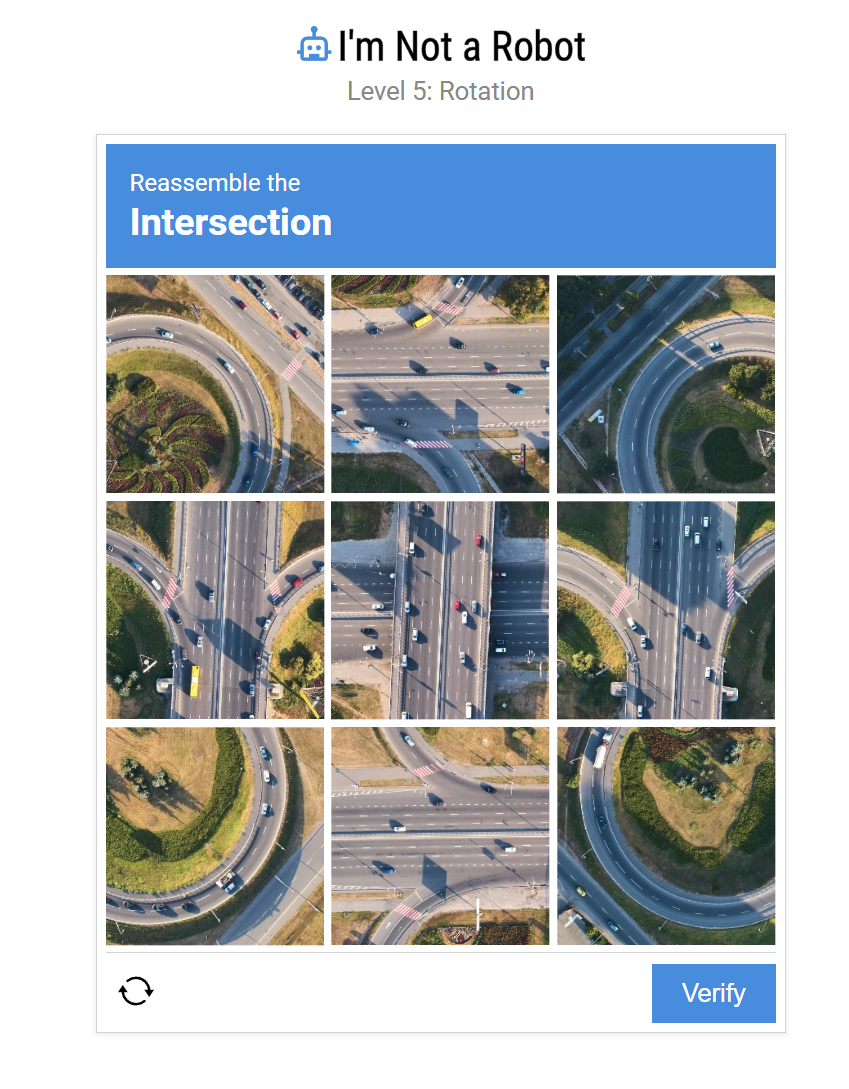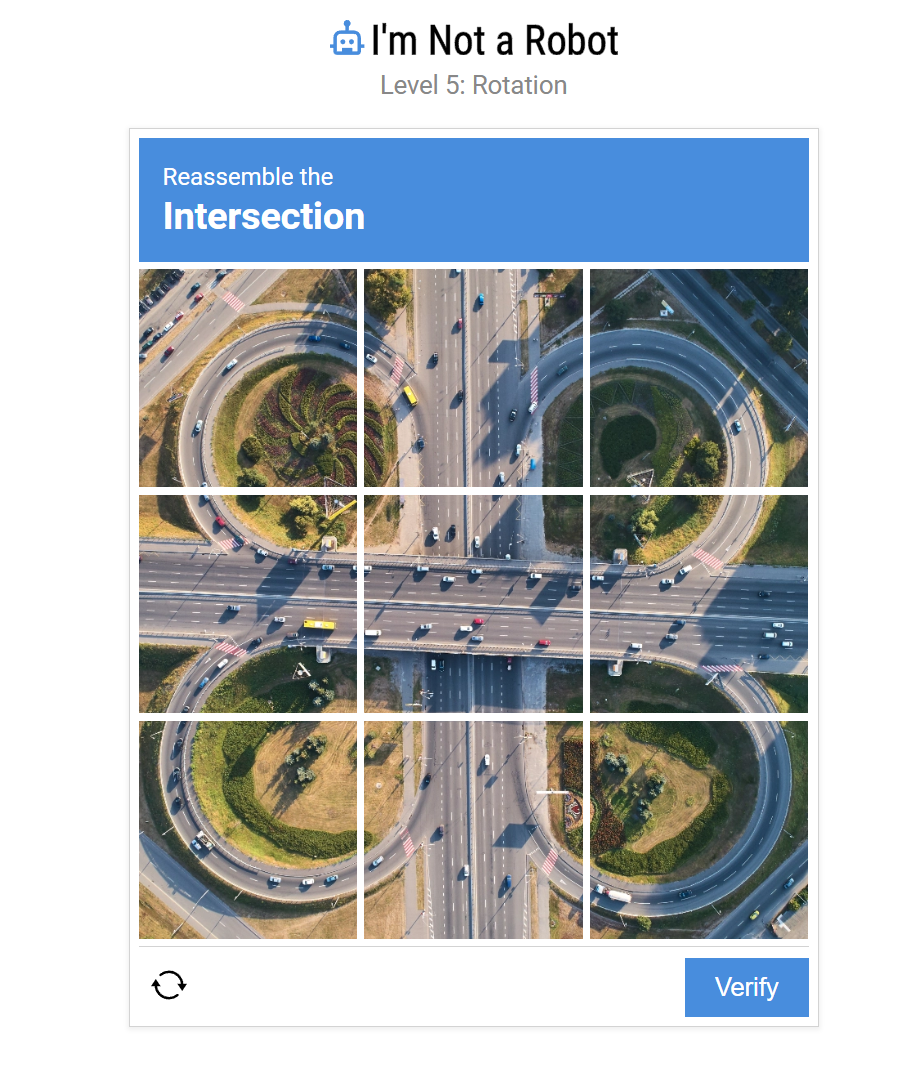How to Beat Level 5 in I'm Not a Robot - Rotation Puzzle Guide
TL;DR
- Objective: Conquer Level 5 of Neal.Fun's 'I'm Not a Robot' rotation puzzle by reassembling a road intersection.
- Steps: Rotate 9 puzzle pieces to connect all road segments into a complete intersection.
- Verification: The game interface will display a 'Success' message or advance to the next level.
- Risk: Incorrect rotations or misaligned road segments will result in failure, requiring puzzle reset.
This guide provides a precise walkthrough for overcoming Level 5 of Neal.Fun's 'I'm Not a Robot' game, specifically the challenging rotation puzzle. Players often find this level frustrating due to its spatial reasoning requirements and the need for systematic piece alignment. This article breaks down the solution into actionable steps, ensuring efficient puzzle completion.
Unlocking Level 5: The 'I'm Not a Robot' Rotation Puzzle Explained
Level 5 of Neal.Fun's 'I'm Not a Robot' game introduces a unique spatial puzzle centered around road intersection reconstruction. Unlike traditional image-based CAPTCHAs, this puzzle challenges players' spatial reasoning and pattern recognition abilities. The challenge lies in understanding how individual puzzle pieces connect to form a cohesive road network. Many players encounter difficulty due to the abstract nature of the puzzle pieces and the requirement for systematic rotation strategy.

Level 5 Rotation Puzzle Overview
Mastering the Rotation Puzzle: A Step-by-Step Guide to Level 5
The key to successfully navigating Level 5 of 'I'm Not a Robot' lies in understanding the spatial relationships between puzzle pieces and applying systematic rotation techniques. The puzzle presents a 3x3 grid of road segments that must be rotated to form a complete intersection. Follow these precise steps to complete the rotation verification process:
Step 1: Analyze Corner Pieces
- Objective: Identify and correctly orient the four corner pieces of the intersection.
- Procedure: Corner pieces contain curved road segments that must curve inward toward the center. Click each corner piece to rotate it until the road curves appropriately. Top-left should curve from bottom to right, top-right from left to bottom, bottom-left from top to right, and bottom-right from left to top. Ensure each corner piece creates a smooth transition toward the center intersection.
Step 2: Align Edge Pieces
- Objective: Position the four edge pieces to create straight road connections.
- Procedure: After securing corner orientations, focus on the edge pieces. Top and bottom edges should display horizontal road segments (left-right orientation), while left and right edges should show vertical road segments (up-down orientation). Rotate each edge piece until it creates seamless connections with adjacent corner pieces.
Step 3: Complete Center Intersection
- Objective: Orient the center piece to connect all surrounding road segments.
- Procedure: The center piece is crucial as it must connect to all four adjacent pieces. Rotate the center piece until it forms a cross-intersection pattern, allowing roads from all directions to meet properly. This piece typically requires a four-way intersection configuration.

Level 5 Completed Solution
Verification: Confirming Success
- Objective: Ensure the puzzle recognizes your rotation configuration as correct.
- Procedure: After aligning all nine pieces, the system will process your solution. A successful completion typically results in the game advancing to the next level or displaying a confirmation message like 'Verification Complete'. If the puzzle resets or prompts for another attempt, re-evaluate your piece orientations, paying close attention to road continuity and connection points.
Common Mistakes and Troubleshooting
- Random rotation: Clicking pieces without systematic analysis will lead to confusion. Always analyze the required orientation before rotating.
- Ignoring connections: Each piece must connect seamlessly with adjacent pieces. Gaps or misalignments indicate incorrect orientations.
- Rushing the process: Take time to visualize the complete intersection before making rotations. Hasty clicking often results in more confusion.
Behind the Puzzle: Decoding Neal.Fun's Logic for Spatial Challenges
Neal.Fun's 'I'm Not a Robot' game cleverly incorporates spatial reasoning challenges that test human cognitive abilities distinct from automated systems. The rotation puzzle specifically targets spatial intelligence and pattern recognition skills that are inherently human. Unlike simple image recognition tasks, this puzzle requires understanding of geometric relationships and systematic problem-solving approaches.
The underlying logic emphasizes the importance of methodical thinking over random trial-and-error approaches. This design choice reflects real-world problem-solving scenarios where systematic analysis leads to more efficient solutions. The puzzle serves as a commentary on the complexity of human spatial reasoning and its role in distinguishing human users from automated systems.
Pro Tips for Conquering 'I'm Not a Robot' Spatial Puzzles
Navigating spatial challenges in 'I'm Not a Robot' requires specific strategies that leverage human spatial intelligence. Beyond the specific Level 5 solution, certain approaches can significantly improve your success rate across similar spatial puzzles.
Tip 1: Start with Reference Points
- Objective: Establish fixed reference points to guide systematic solving.
- Details: Always begin with corner pieces as they provide the most constraints and serve as anchors for the entire puzzle. Corner pieces have the most defined orientations and offer clear visual cues for proper alignment. Use these as reference points to determine the orientations of adjacent pieces.
Tip 2: Work from Outside to Inside
- Objective: Build the puzzle systematically from edges toward the center.
- Details: After securing corners, focus on edge pieces before tackling the center. This approach reduces complexity by establishing the puzzle's framework first. Edge pieces have fewer possible orientations than the center piece, making them easier to solve systematically.
Tip 3: Visualize the Complete Pattern
- Objective: Maintain awareness of the overall intersection design throughout the solving process.
- Details: Before making any rotations, spend time visualizing what the completed intersection should look like. This mental model will guide your rotation decisions and help you recognize when pieces are correctly oriented. A complete road intersection should have smooth, continuous road flow in all directions.
Tip 4: Use the Refresh Option Strategically
- Objective: Reset the puzzle when configurations become too complex to untangle.
- Details: If you find yourself with a heavily scrambled configuration, don't hesitate to use the refresh button to start over. Sometimes a fresh start with systematic approach is more efficient than trying to fix a complex misalignment. This is particularly useful when multiple pieces are incorrectly oriented.
Frequently Asked Questions About 'I'm Not a Robot' Rotation Puzzles
Players often have similar questions when tackling Neal.Fun's 'I'm Not a Robot' spatial challenges. Here are answers to some frequently asked queries:
-
Q1: Why does my Level 5 puzzle fail even when roads seem connected?
-
A1: Level 5 requires precise alignment where all road segments flow smoothly without gaps or misalignments. Even small orientation errors can cause failure. Ensure each piece creates seamless connections with all adjacent pieces.
-
Q2: Is there only one correct solution for the rotation puzzle?
-
A2: Yes, Level 5 has a specific correct configuration where all road segments form a complete, continuous intersection. While individual pieces might have multiple possible orientations, only one combination creates the required complete intersection pattern.
-
Q3: How can I improve my spatial reasoning for these puzzles?
-
A3: Practice visualizing complete patterns before making moves, work systematically from corners to center, and take time to analyze piece relationships. Regular exposure to spatial puzzles and geometric problems can enhance your spatial reasoning abilities.
-
Q4: What should I do if pieces seem to fit but the puzzle doesn't accept my solution?
-
A4: Double-check that all road segments create continuous, smooth connections without any gaps or abrupt direction changes. Sometimes pieces may appear aligned but have subtle orientation errors that prevent proper road flow.
-
Q5: Are there visual cues that indicate correct piece orientation?
-
A5: Yes, look for smooth road curvature, consistent road width at connection points, and natural traffic flow patterns. Correctly oriented pieces will create visually coherent road segments that appear as they would in real-world intersections.
Final Summary
Successfully navigating Level 5 of 'I'm Not a Robot' hinges on systematic rotation of puzzle pieces to create a complete road intersection. Overcoming this level requires spatial reasoning skills and methodical problem-solving rather than random trial-and-error approaches. To prepare for future spatial challenges, always analyze the complete pattern first, work systematically from corners to center, and remember that precision in alignment is crucial for success.